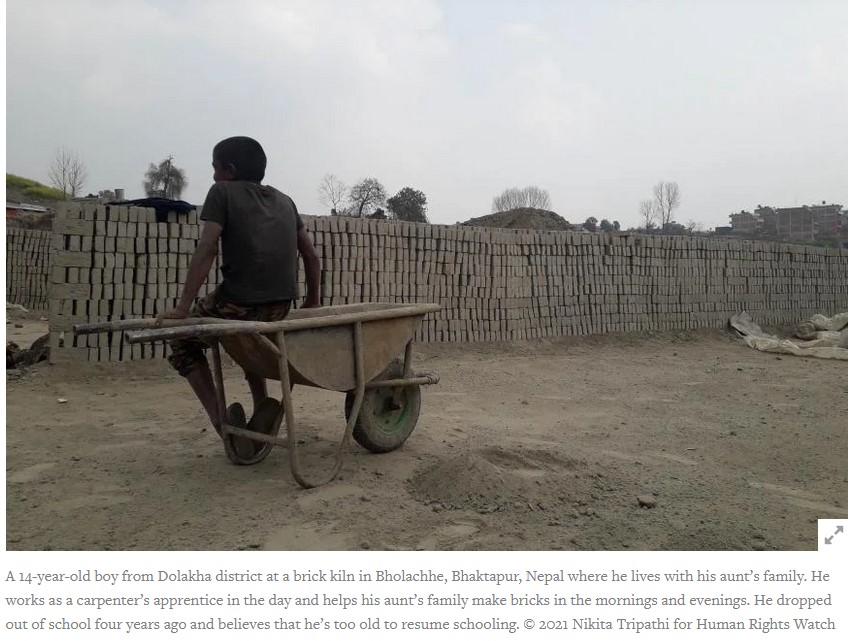Ending Child Labor in Mica Mines in India and Madagascar
By Katarzyna Rybarczyk

Katarzyna Rybarczyk
Most people use products containing mica daily, without realizing what the story behind their production is. Mica is a mineral commonly found in products such as cosmetics, paints, and electronics. For most people living in the West, mica is simply something that makes these products shiny. However, extracting mica is often linked to the worst forms of child labor.
India and Madagascar are the two largest exporters of sheet mica globally, with most mica mining happening in illegal mines. The two countries are also the most associated with using children to extract the mineral.
Areas where mica mines are located struggle with high poverty rates, so mining mica is often the only thing that lets families put food on the table and survive. With families struggling to earn a living, children often have to supplement their parents’ income.
As mica mining is unregulated and, for the most part, thrives in hiding, there are many dangers associated with it.
The scale of the problem
The majority of illegal mica mines in India are located in just two states Bihar and Jharkhand, which are among India’s most impoverished. The governance there is weak, so the industry is subject to few, if any, regulations and labor exploitation of both adults and children occurs frequently.
It is estimated that 22,000 children work in mica mines in Jharkhand and Bihar, but as mines that employ children do not report it, giving the exact numbers is impossible.
According to the findings of the US Department of Labor, in Madagascar, around 10,000 children work in the mica sector.
Most of the mines are located in the southern region of Madagascar, where children are charged with tasks ranging from building the mines to extracting and sorting the mineral.
In the country, children ‘make up half of all workers in mica mines’, research by Terre Des Hommes revealed.
Even though the respective governments are aware of child labor being prevalent in mica mines, they lack appropriate resources to address and solve the issue. Moreover, as unemployment rates are high and professional opportunities are limited, mining mica is often the only income-generating activity for families living in the mines’ vicinity.
In India, for their labor, children who mine mica get around fifty rupees a day, equivalent to less than seventy cents. The rates are similar in Madagascar. As the mica goes through a supply chain, however, wholesalers can get more than a thousand US dollars for a kilogram of it. That illustrates how unjust the industry is and how severe human rights violations happening in mica mines are.
Dangers for children
Mining mica is a labor intensive process that requires going into narrow shafts that frequently collapse and trap children under the rocks. To find mica, children are forced to go underground, where they often find themselves in complete darkness.
The tunnels caving in is not the only threat to children mining mica, however. They are constantly exposed to dust, which can lead to pneumonia and other respiratory illnesses. In addition to that, lacking appropriate tools, most children use their bare hands to mine mica, which frequently results in cuts and skin infections.
Working in illegal mines puts children at risk of further problems such as physical abuse or modern slavery. ‘Young girls are also vulnerable to commercial sexual exploitation around mica mining sites’, US Department of Labor wrote in the Report on the Worst Forms of Child Labor.
To get paid, children need to fill in an entire basket with flakes of mica. That often requires them to spend a whole day in the mine, which means they do it instead of going to school. Growing up mining mica instead of getting an education traps children in a never-ending cycle of abuse and suffering and limits their future employment opportunities.
Ending child labor in mica mines
Knowing how exploitative the mica supply chain can be, some end-users decide to abandon products containing the mineral altogether, and others turn to synthetic mica. In theory, it can seem like a sustainable solution – if the demand for mica decreases, fewer children will be involved in mining it. In practice, however, the production process of synthetic mica often lacks transparency, making it impossible to state that this alternative is entirely child labor-free. Furthermore, if we completely stopped using mica products, we would deprive thousands of families of their only way to get money.
Without mica, entire communities in India and Madagascar would be forced into extreme poverty. The moral dilemma of whether to use mica or not is evident, and finding a solution to the problem is challenging.
Merely boycotting products containing mica is not the right answer. Instead, empowering children and their parents, teaching them about the importance of education, and providing them with professional training and skills that would allow them to find employment elsewhere is essential. Thanks to that, their dependence on illegal mica mining would be reduced, and Indian and Malagasy children could live a happy childhood, free from exploitative labor.
Author’s bio:
Katarzyna Rybarczyk is a Political Correspondent for Immigration News, a media platform affiliated with Immigration Advice Service. Through her articles, she aims to raise awareness about security threats worldwide and the challenges facing communities living in developing countries.
Editor’s Note:
In February 2021, the U.S. Department of Labor awarded $4.5 million in grant-funding to reduce child labor in Madagascar’s mica-mining communities. We urge you to watch this compelling 2019 NBC News video about mica mining in Madagascar from the Today Show:


 The children worked at brick kilns, carpet factories, gold mines, stone quarries, fisheries, in construction, and in agriculture. Others sold food or goods on the street. They described working long hours for meager wages, often under dangerous conditions. One 12-year-old girl crushed rocks at a stone quarry for seven hours a day. Her salary was just US$1.11 a week, she said, but if her employer was unhappy with the size of the stones, he paid her even less.
The children worked at brick kilns, carpet factories, gold mines, stone quarries, fisheries, in construction, and in agriculture. Others sold food or goods on the street. They described working long hours for meager wages, often under dangerous conditions. One 12-year-old girl crushed rocks at a stone quarry for seven hours a day. Her salary was just US$1.11 a week, she said, but if her employer was unhappy with the size of the stones, he paid her even less.